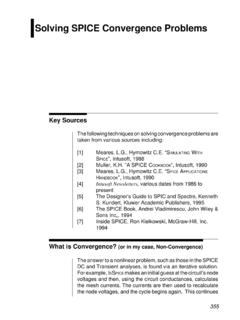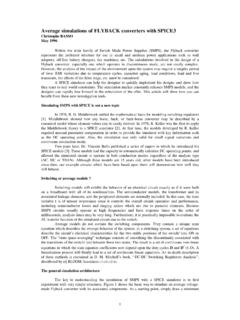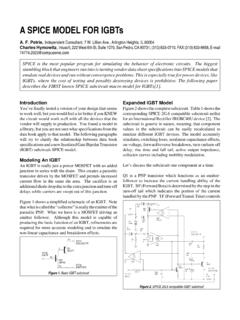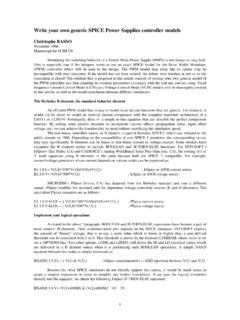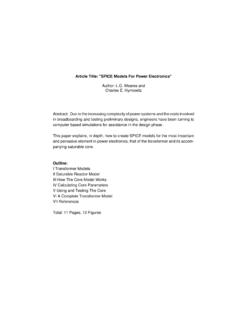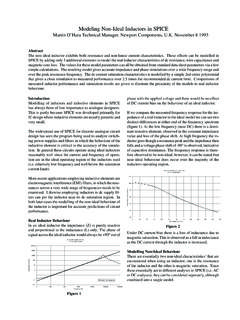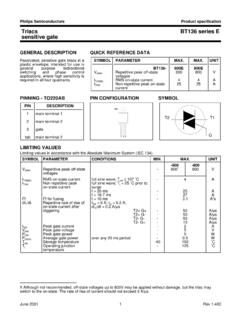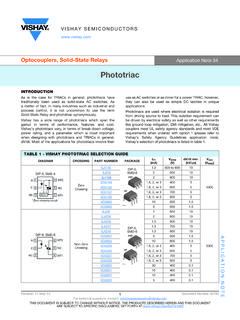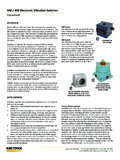Transcription of A SPICE MODEL FOR TRIACs (preliminary version; …
1 IntroductionBerkeley SPICE is the most popular program for simulat-ing the behavior of electronic circuits. The biggest stum-bling block most engineers run into is turning companyspecifications or vendor data sheets into SPICE devicemodels that emulate real devices and run without prob-lems. Here is an approach which works well for an TRIACand derives directly from data book triac is a bi-lateral switch that can be triggered intoconduction regardless of its polarity. It is modeled byusing two NPN/PNP transistor pairs connected back-to-back as shown on the left of Figure 4. The base of eachtransistor is connected to the collector of the other. Thisproduces positive feedback, resulting in the required switch-ing action. At MT2, the emitter metallization overlaps thebase of the NPN transistor. This forms a lateral resistor inthe base (P) region and is shown as RH in the MODEL . RHdetermines the holding current of the triac. A similarresistor exists at MT1.
2 These resistors hold the triac offunless triggered by the gate or the holding current from aprevious on this configuration has the basic triggering func-tion of the triac, it must be enhanced to emulate otherimportant parameters such as off state leakage, breakovervoltage and current, and voltage and current characteris-tics in all four modes of operation. Figure 4 shows the fulltriac subcircuit. Resistors and zener diodes are used tosimulate the breakdown voltages and leakage sources are used to emulate the various trigger-ing modes and to allow a wider range of trigger data to adjusting the MODEL parameters for the triac subcircuitseems a little daunting, you can use SPICEMOD. SPICEMODis a software program that quickly converts data bookparameters into SPICE MODEL parameters. Entering onlythe device type and maximum voltage and current ratingswill produce a realistic MODEL as all other parameters areA SPICE MODEL FOR TRIACs ( preliminary version ; incomplete)A.
3 F. Petrie, Independent Consultant, 7 W. Lillian Ave., Arlington Heights, IL 60004 Charles Hymowitz, Intusoft, 222 West 6th St. Suite 1070, San Pedro, CA 90731, (310) 833-0710, FAX (310) 833-9658, is the most popular program for simulating the behavior of electronic circuits. The biggeststumbling block that engineers run into is turning vendor data sheet specifications into SPICE models thatemulate real devices and run without convergence problems. This is especially true for power devices, likeTriacs, where the cost of testing and possibly destroying devices is prohibitive. The following paperdescribes the FIRST known SPICE subcircuit macro MODEL for a Triac[1].Figure 2. Basic Triac subcircuitMT1 GateMT2 RHRHQN1 NOUTQP2 POUTQN2 NOUTQP1 POUTF igure 1. Basic Triac structurescaled from them. Naturally, the more data you enter, themore exact the MODEL will be. Figure 5 shows the triacentry screen from MODEL and method are used for the TRIAC in theSPICEMOD ( ) program.
4 This program allows directconversion of data book information to SPICE models fordiodes, zeners, bipolar transistors, JFETs, MOSFETs,SCRs and now TRIACs . Models can be generated as fast asdata can be entered. This makes it easy to generate modelsfor custom or house devices. Limit devices can bemodeled by entering limit device data. Because thesemodels use standard SPICE syntax, they can be used withany program that adheres to SPICE books may show the same values for all four gatetrigger current and voltage modes. However, the valuesare different in all four modes. In a real triac, when the gateis driven with the opposite polarity from the MT2 termi-nal, the gate must supply enough current to drive theshunting resistance to twice the gate voltage, thus thetrigger current cannot be the same for both polarities,regardless of what the data book limits say. G+ with MT2-always requires more gate drive than other modes. In thiscase, it is only necessary to enter the first mode gatevoltage and current and let the program estimate the othersfor the most realistic MODEL .
5 SPICEMOD guards againstentering grossly unrealistic data and will attempt to pro-duce the closest realistic MODEL in these SPICE 2G compatible netlist for the triac is shown inTable 1 (next page). Along with the Affects column inTable 1. 2N5568 Triac 2N5568 1 2 3* TERMINALS: MT2 G MT1 Mot. 400V 10 AQN1 5 4 3 NOUT; Output TransistorsQN2 11 6 7 NOUT; OFF keyword for Q devicesQP1 6 11 3 POUTQP2 4 5 7 POUTDF 4 5 DZ; Forward breakdown diodeDR 6 11 DZ; Reverse breakdown diodeRF 4 6 40 MEG; Forward leakage current (controls IDRM).RT2 1 7 ; Controls on resistanceRH 7 6 75; Controls reverse holding currentRGP 8 3 ; Controls forward holding current and triggercurrentRG 2 8 ; with RGP controls VGTRS 8 4 ; with RGP controls forward holding currentDN 9 2 DIN; Diode to isolate G- triggering modesRN 9 3 ; Controls current in G- trigger modesGNN 6 7 9 3 ; Controls G-, MT2- trigger voltagesGNP 4 5 9 3 ; Controls G-, MT2+ trigger voltagesDP 2 10 DIP; Diode to isolate G+, MT2- trigger modeRP 10 3 ; Controls current in G+, MT2- trigger modeGP 7 6 10 3 ; Controls G+, MT2- trigger DIN D (IS= ); Conducts in G- DIP D (IS= N= ) ; Higher drop diode conducts only inG+, MT2- DZ D (IS= N= IBV=10U BV=400).
6 MODEL POUT PNP (IS= BF=5 CJE=235P TF= ). MODEL NOUT NPN (IS= BF=20 CJE=235P CJC= TF= ).ENDST able 1, SPICE 2G Triac MODEL generated by the SPICEMOD modelingprogram from manufacturer s data sheet 2. SPICE compatible Triac subcircuitMT1RH75RF40 MEGRT2 (1)MT2V(3)MT1QN2 NOUTQP1 POUTV(2)GATEDFDZDRDZ67415382910112N5568 valuesare shownFigure 5 you can get an idea of the relationship betweenwhich data sheet parameters correspond to which SPICE MODEL in Voltage in Volts800M600M400M200M0 GATE Voltage in Volts12IG0IT2X42N5568V(6)ANODEVV(1)GATEV 126 Figure 6, DC analysis of the Motorola 2N5568 FREE models are posted on the Intusoft Web 4 shows the SPICE subcircuit that I developed tosolve these problems. Replacing the trigger transistorswith diodes and voltage controlled current sources re-duces the number of SPICE parameters needed and pro-vides some isolation between the four modes of gate connections still emulate the feedback to the 1 lists the.
7 SUBCKT for this same MODEL . QN1, anNPN transistor, has a forward beta of 20 and is connectedto the gate at its base. QP2, a PNP transistor, is connectedto MT2 and QN1 in a positive feedback mode. Due to thefact that there are two stable states (on and off) for theTRIAC, it is necessary to add the OFF statement afterthe transistors in the .SUBCKT MODEL or SPICE maynever evaluate the off condition or may hang due to theuncertainty. The OFF command causes SPICE to start thecalculations assuming the off condition. If the device isreally on , there is no stable off state, so the OFFcommand has no effect on the accuracy of the result. (Hint:any time SPICE is used to evaluate a bi-stable device, theOFF or ON command must be used to obtain the correctstate.) TRIACs have two stable states. Therefore, it may be neces-sary to tell SPICE which state to use, especially when youwant to start a simulation with the triac in the off state. Todo this you can issue the OFF keyword on the subcircuittransistor 6 shows the low current region of a Motorola2N5568 triac with no input applied to the gate.
8 This curvewas generated by holding the current to the gate at zero andsweeping the MT2 current from -50mA to +50mA. Theslope of the curve at the zero axis is determined by theIDRM specification. The maximum voltage swings in theoff state are determined by the VDRM specification. Thetrigger points (+6 and -10mA) are determined by theholding behavioral triac models are included withISSPICE4. Their superior simulation speed and idealizedresponse can make them useful for investigating triaccontrol circuitry. However, with power devices such as thetriac, you will normally need models that exhibit 2nd ordereffects as well. Without them you can t run realisticFigure 3, Data sheet parameters (above left) used to create the SPICE TRAIC subcircuit (Table 1). To make a newmodel, data sheet values are entered into the SpiceMod entry screen. As they are entered the subcircuit values arecalculated. The more data that is entered, the more accurate the final MODEL will be.
9 The subcircuit parametersaffected by each entered parameter are shown to - TRIAC GATE TRIGGER NOMOD NOPAGE RELTOL=.01 ITL1=500 ITL2=1500*.DC IG 0 VCC -12 12 24* ^ Gate Trigger Curve* Note: for some triac models the DC analysis will* not converge. The Transient analysis may be 1u 1m DC V(1) V(2).PRINT TRAN V(1) V(2)*ALIAS V(1)=MT2 VOLTAGE*ALIAS V(2)=GATE VOLTAGE*ALIAS IT2=MT2 CURRENT*ALIAS IG=GATE CURRENT*INCLUDE * ^ Use your library path and 3 0 -12V ; or 12V* ^Set for the proper biasing if using transientRL 3 1 100* ^Adjust for 0 2 0 pulse 0 0 1MX1 1 2 0 T435-800 ; 2N5568* ^ Change to desired 6. The switching circuit used to test the transientTriac Most other SPICE vendors do not offer suchsophisticated power semiconductor models. Fortunately,Intusoft 5 is a SPICE plot of the low current region of aMotorola 2N5568 TRIAC with no input applied to thegate. This curve was generated by holding the current tothe gate at zero and sweeping the MT2 current from -50mA.
10 To +50 mA. The slope of the curve at the zero axis isdetermined by the IDRM specification. The maximumvoltage swings in the off state are determined by theVDRM specification. The trigger points (+ 6 and -10 this case) are determined by the holding current speci-fication (controlled by resistors RS, RGP and RH in figure3). Table 2 shows the SPICE file used to generate thisanalysis. (The subcircuit is brought in with the *IN-CLUDE statement in IS- SPICE .)There are four gate trigger modes that must be first mode is similar to an SCR with MT2 positive andthe gate also positive. For convenience, this is combinedwith the fourth mode where the gate is also positive andMT2 is negative. Figure 6 is a plot of MT2 voltage versesgate current using a 12 volt supply and a 100 ohm loadresistor. Note that the device turns on at the specified 11mA. when MT2 is positive and at 31 mA. of gate currentwhen MT2 is negative. The first mode gate current andvoltage are controlled by RG and RGP in figure 4.
